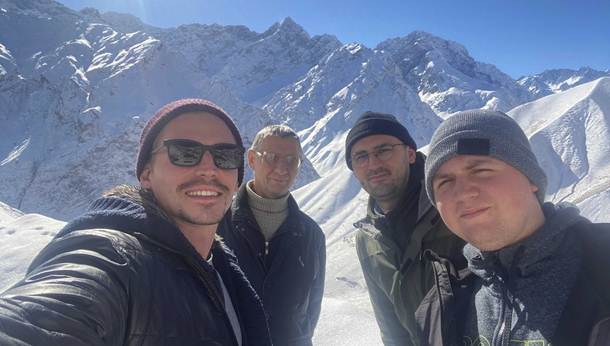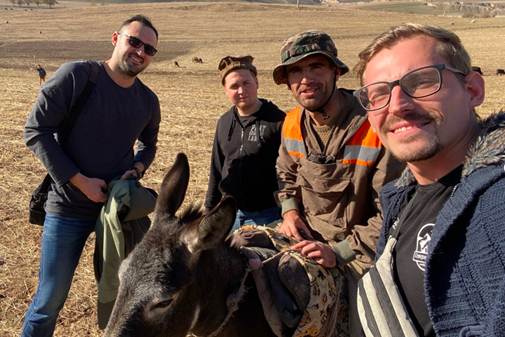Russian Archaeologists Discover 2.5 Million Year Old Bones in an Ancient Fortress Near Baljuvon
Read also

DUSHANBE, 10.12.2021 (NIAT Khovar) – A group of Russian archaeologists discovered animal bones from the early Pleistocene period in the archaeological sites in the basin of the Kyzylsu river in the south of Tajikistan near Baljuvon ditrict, reports the press service of the Russian Ural Federal University.
They explored the Lohuti and Kuruksoy tracts, where they unearthed the remains of the ancient hyena Pliocrocuta, Stenon horse, Shotenzak bison, several species of ancient deer and rhinoceroses. The finds are chronologically similar to the deposits of the Taurida Cave and they are 2.2-2.5 million years old.
The expedition was attended by specialists from the Institute of Plant and Animal Ecology of the Ural Branch of the Russian Academy of Sciences, the Laboratory of Natural Science Methods in Humanitarian Research of the Ural Federal University, and the Ahmadi Donish Institute of History, Archeology and Ethnography of the National Academy of Sciences of Tajikistan.
According to paleontologist Dmitry Gimranov, the Lohuti and Kuruksoy tracts were studied from 1960 until 1980 when the research was stopped.

Scientists feared that geological dynamics, mudflows and water could erode the sediments. To the delight of specialists, the layer seemed open and accessible to study.
Most of the finds were transferred to the Museum of History and Local Lore of the Baljuvon district, which was opened earlier this September by President Emomali Rahmon.
Scientists will be engaged in the restoration, research and analysis of samples as early as next season.

The study of the area will continue. Only ungulate teeth were taken to Russia’s Yekaterinburg.
Scientists also discovered a burial ground of the Late Bronze Age in Farkhor, settlements of the Early Bronze Age in Sarazm, the fortress of the Hellenistic time Zoli-Zard and the medieval settlement of Mustafoteppa located 1 km southeast of the ancient settlement of Sarazm.
“All bone remains belong to pets. The exception is the complete skeletons of a rat and a turtle, which entered the cultural layer, probably without human participation,” explains Anton Kochnev, researcher at the Laboratory of Natural Science Methods in Humanitarian Research of the Russian Ural Federal University.
“The data obtained will help us reconstruct the animal husbandry of the ancient population of eastern regions of Central Asia,” he added.












 Tajikistan to host Chinese Culture Days
Tajikistan to host Chinese Culture Days National Museum of Tajikistan to Exhibit Artifacts at International Exhibition in China
National Museum of Tajikistan to Exhibit Artifacts at International Exhibition in China Filmmakers from 20 Countries to Participate in the International “Toji Somon” Film Festival
Filmmakers from 20 Countries to Participate in the International “Toji Somon” Film Festival Opening Ceremony of the Days of Mongolian Culture Held in Tajikistan
Opening Ceremony of the Days of Mongolian Culture Held in Tajikistan President of Mongolia Ukhnaagiin Khurelsukh Explores the History of the Tajik People at the National Museum of Tajikistan
President of Mongolia Ukhnaagiin Khurelsukh Explores the History of the Tajik People at the National Museum of Tajikistan Mongolian Culture Days to Take Place in Tajikistan
Mongolian Culture Days to Take Place in Tajikistan Ten New Historical and Cultural Sites Discovered in Tajikistan
Ten New Historical and Cultural Sites Discovered in Tajikistan Six Tajik Documentaries to Be Broadcast on Chinese Television
Six Tajik Documentaries to Be Broadcast on Chinese Television Tajikistan Submits Five New Nominations for Inclusion in the UNESCO World Heritage List
Tajikistan Submits Five New Nominations for Inclusion in the UNESCO World Heritage List Tajik Gymnasts Win 15 Medals at International Rhythmic Gymnastics Competition
Tajik Gymnasts Win 15 Medals at International Rhythmic Gymnastics Competition Tajikistan’s Contribution to Cultural Heritage Preservation in the Era of Globalization Presented in Kazakhstan
Tajikistan’s Contribution to Cultural Heritage Preservation in the Era of Globalization Presented in Kazakhstan














